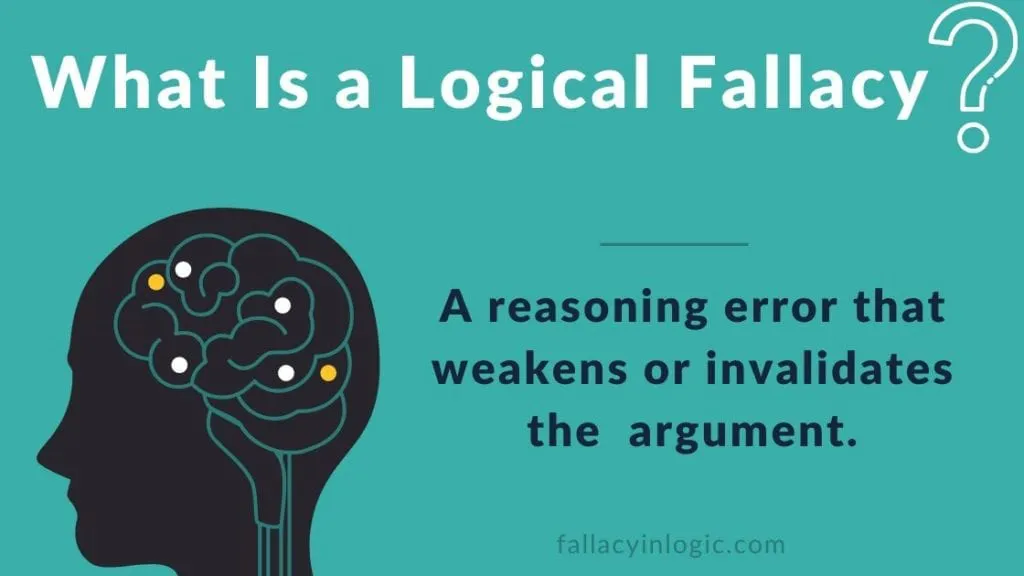I’ve argued my fair share of things on the internet. Most of the arguments I enjoy because I love seeing different points of view. I’ll argue back and forth with those people all day long. It’s enjoyable for me. These people are typically unpleasant to talk to because they use logical fallacies such as Ad Hominem attacks and straw man attacks to show some sort of superiority. Most of the time they don’t know they are doing it and claim it is based on some sort of observation.
When these types of fallacies start happening I often times will not engage any further with people because they don’t understand the illogical nature of their argument and then I have to argue against an illogical argument. It’s one thing to have a differing opinion but quite another to push a logical fallacy as proof of something. Other times I will still engage if the person doesn’t understand his argument is illogical.
Let me give you a couple of examples of the most common logical fallacies that I see.
Straw Man
This is by far the most common fallacy I see. It occurs when someone distorts or misrepresents an argument to make it easier to attack. Let’s look at an example.
Example 1
Debra: There is no logical or moral justification for the killing of animals for food. Animals are sentient creatures that deserve the same consideration as humans.
Joe: Look, if you want to eat grass like a cow, Bon Appetit! Just let me have my hamburger.
In this argument, Debra was making the argument that animals should not be killed because they are sentient. Joe distorted that argument to mean that Debra simply wanted to eat grass. Debra made no such argument
Example 2
John: I don’t believe anyone needs a silencer on their gun and they should be outlawed.
Lane: Stop being so against the second amendment, I have a right to bear arms.
Lane distorts John’s argument to mean that John is against the second amendment. This is not an argument that John made. His argument was against silencers, not guns in general.
The second logical fallacy that is often used is Ad Hominem. This appears in many different ways usually it appears in the form of calling someone else a name. Calling someone Hitler is popular but Boomer has crept up lately. Let’s look at some examples.
Example 1
How can you argue your case for vegetarianism when you are enjoying that steak?
In this argument, the case for vegetarianism is never considered because the person making the case is eating meat. It’s an attack on the person and not the argument.
Example 2
A: “All murderers are criminals, but a thief isn’t a murderer, and so can’t be a criminal.”
B: “Well, you’re a thief and a criminal, so there goes your argument.
The attack here is on the person and not the argument. The logical argument was never considered.
Example 3
A: “Unemployment has increased due to the action of this president”
B: “That information can’t possibly be true because it comes from Fox News.”
An argument is completely dismissed and the source is attacked.
These are two fallacies in a long list of logical fallacies. Here is a list of 15 Logical fallacies to pursue when you have some time. The reason I bring up logical fallacies is that they play an important role in domination on the internet. Domination language is used to try and get someone to submit to your point of view by ridicule or mockery. The point is to belittle someone into submission.
This language and type of argument has become nearly defacto on internet discussion boards and has become the primary method of social change. Language domination and shame are the methods used by so-called social justice warriors and cancel culture. They focus is not on the logical argument but on the moral superiority found in shaming people. Let’s look at some examples of how this works.
A: I believe that a fetus is a human being and should not be aborted.
B: How can you be against a woman’s right to choose? You are a man and have no right to tell a woman what to do. The patriarchy is such a problem.
A: I have said nothing about a woman’s right to choose.
B: My observations are on point.
There are three logical fallacies in this argument.
- B misrepresented the argument(Straw Man) of A by interpreting it as a women’s right to choose. That is a seperate(but related) issue of a woman’s right to choose.
- Second B engaged in an Ad Hominem attack by telling A that the patriarchy is the problem(a group to which A belongs). The fact that A belongs to the “patriarchy” has no relevance to the argument made by A.
- There is a fallacy called a non-sequitar. A non-sequitar is a conclusion or statement that does not logically follow from the previous argument or statement. When B says “You are a man and have no right to tell a woman what to do”, B’s conclusion does not logically follow the assertion that fetus is not a human being.
I don’t think that people know that they are engaging in such things for the most part. They think that they are just observing and reporting on their observations. This is largely not the case. Most people are trying to translate and interpret meaning from their observations. We as humans translate signs in terms of our own understanding and we try and make sense of the world through our own experiences, understanding, and moral code. However, we can’t afford to simply interpret things through our own lens. We must understand the logic of our thoughts and actions. We all engage in logical fallacies from time to time(it’s part of our existence as emotional creatures) however, we need to be aware of how to spot these false arguments and domination tactics and overcome them. I’m not sure it is possible to do this on a large scale but it has to start with the awareness of the use of logic in our arguments.





